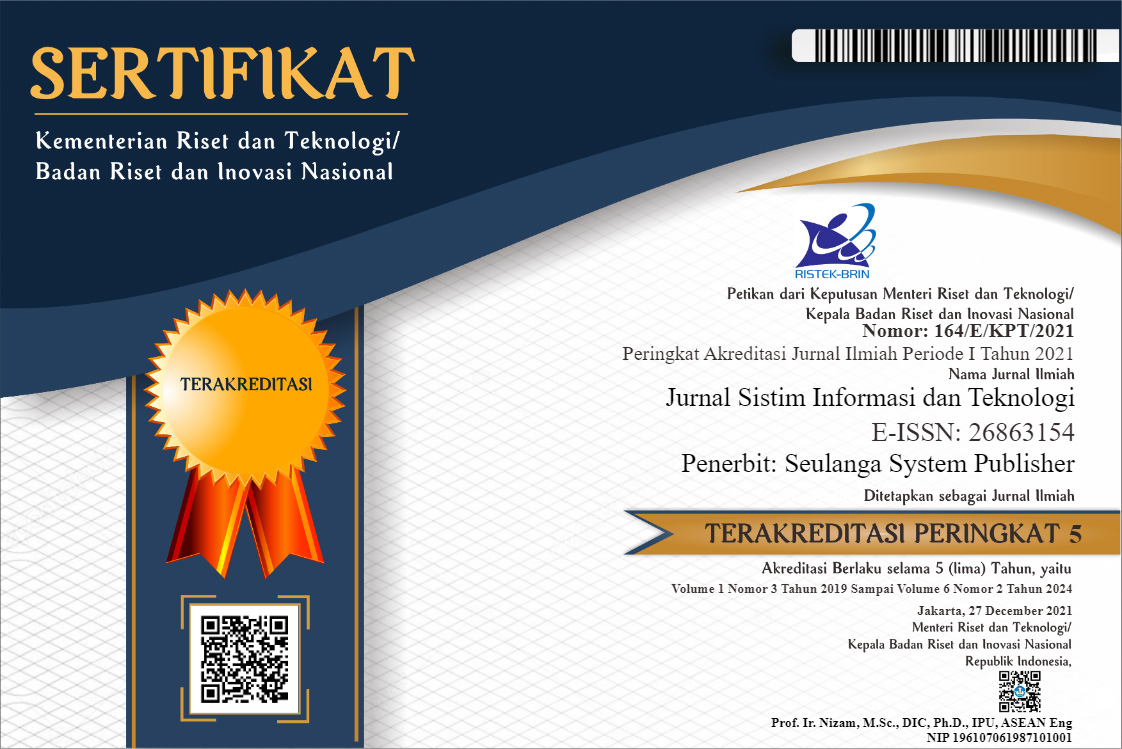Data Mining Menggunakan Algoritma K-Means untuk Klasifikasi Penyakit Infeksi Saluran Pernafasan Akut
DOI:
https://doi.org/10.37034/jsisfotek.v4i1.117Keywords:
Data Mining, K-Means, Cluster, RapidMiner, Acute Respiratory Infection (ISPA)Abstract
Acute Respiratory Infection (ISPA) is. Diseases that can attack one or more parts of the respiratory tract, from the nose (upper tract) to the alveoli (lower tract) including adnexal tissues such as sinuses, middle ear cavity, and pleura. And ISPA is also a type of infectious disease, especially to people who have abnormalities in the immune system, the elderly, and children whose immune systems are not yet fully formed. ISPA is a contagious disease in the world caused by the main cause of morbidity and mortality. And ISPA can reach four million people die every year and 98% of them are caused by lower respiratory tract infections. In Indonesia even ranks first cause of death in children and adults. ISPA in Indonesia ranks first cause of death in children and adults. ISPA also occupies the list of 10 most diseases. To get precise and fast accuracy in classifying the symptoms of ISPA. In this study, there were 250 patient data sourced from the Rahmatan Lil Alamin Clinic. Furthermore, the data is processed using RapidMiner software. Produced 3 clusters, namely cluster C1 (Ordinary ISPA) with 141 members, cluster C2 (Medium ISPA) with 17 members, C3 (severe ISPA) cluster with 7 members. . The test results for cluster 1 get 62 data sets, cluster 2 get 60 data sets and cluster 3 get 43 data sets. because the number of data sets from cluster 3 is smaller, the cluster can be called optimal.
References
Romli, I. (2021). PENERAPAN DATA MINING MENGGUNAKAN ALGORITMA K- MEANS UNTUK KLASIFIKASI PENYAKIT ISPA. Indonesian Journal of Business Intelligence (IJUBI), 4(1), 10. doi:10.21927/ijubi.v4i1.1727
Hasanah, M., Defit, S., & Nurcahyo, G. W. (2019). Implementasi Algoritma K- Means untuk Klasterisasi Peserta Olimpiade Sains Nasional Tingkat SMA. Jurnal Sistim Informasi dan Teknologi, 1(3), 31-36. https://doi.org/10.35134/jsisfotek.v1i3.7
Joseph, S. I. T., & Thanakumar, I. (2019). Survey of data mining algorithm‟s for intelligent computing system. Journal of trends in Computer Science and Smart technology (TCSST), 1(01), 14-24. https://doi.org/10.36548/jtcsst.2019.1.002
Dewi, S., Defit, S., & Yunus, Y. (2020). Akurasi Pemetaan Kelompok Belajar Siswa Menuju Prestasi Menggunakan Metode K-Means (Studi Kasus SMP Pembangunan Laboratorium UNP). Jurnal Sistim Informasi Dan Teknologi.https://doi.org/10.37034/jsisfotek.v3i1.98
Mirantika, N. (2021). Penerapan Algoritma K-Means Clustering Untuk Pengelompokan Penyebaran Covid-19 di Provinsi Jawa Barat. NUANSA INFORMATIKA, 15(2), 92–98. https://doi:10.25134/nuansa.v15i2.4321
Ahmed, S. R. A., Al Barazanchi, I., Jaaz, Z. A., & Abdulshaheed, H. R. (2019). Clustering algorithms subjected to K-mean and gaussian mixture model on multidimensional data set. Periodicals of Engineering and Natural Sciences, 7(2), 448-457. http://dx.doi.org/10.21533/pen.v7i2.484
Indriyani, F., & Irfiani, E. (2019). Clustering Data Penjualan pada Toko Perlengkapan Outdoor Menggunakan Metode K-Means. JUITA: Jurnal Informatika, 7(2), 109-113. 10.30595/juita.v7i2.5529
Bhargava, A. (2019). Grouping of Medicinal Drugs Used for Similar Symptoms by Mining Clusters from Drug Benefits Reviews. Available at SSRN 3356314. http://dx.doi.org/10.2139/ssrn.3356314
Gustientiedina, G., Adiya, M. H., & Desnelita, Y. (2019). Penerapan Algoritma K-Means Untuk Clustering Data Obat- Obatan. Jurnal Nasional Teknologi Dan Sistem Informasi, 5(1), 17–24. doi:10.25077/teknosi.v5i1.2019.17-24
Hidayat, I. S., Defit, S., & Nurcahyo, G. W. (2021). Simulasi dalam Optimalisasi Pengadaan Barang menggunakan Metode K-Mean Clustering. Jurnal Sistim Informasi Dan Teknologi, 281–286. https://doi.org/10.37034/jsisfotek.v3i4.200
Yang, M.-S., & Sinaga, K. P. (2019). A Feature-Reduction Multi-View k-Means Clustering Algorithm. IEEE Access, 7, 114472–114486. doi:10.1109/access.2019.2934179
Pandiangan, H. (2019). Penerapan Data Mining Dalam Clustering Produksi Daging Sapi Di Indonesia Menggunakan Algoritma K-Means. Journal Of Computer Networks, Architecture and High Performance Computing, 1(2), 37–44. https://doi.org/10.47709/cnapc.v1i2.239
Manullang, S. D., Buulolo, E., & Lubis, I. (2020). Implementasi Data Mining Dalam Memprediksi Jumlah Pinjaman Dengan Algoritma C4. 5 Pada Kopdit CU Damai Sejahtera. Jurnal Sistem Komputer dan Informatika (JSON), 1(3), 265-272. http://dx.doi.org/10.30865/json.v1i3.2153
Singh, S., & Singh, P. (2020). Speaker specific feature based clustering and its applications in language independent forensic speaker recognition. International Journal of Electrical and Computer Engineering (IJECE), 10(4), 3508.doi:10.11591/ijece.v10i4.pp3508-3518
Sinaga, K. P., & Yang, M.-S. (2020). Unsupervised K-Means Clustering Algorithm. IEEE Access, 8, 80716–80727. doi:10.1109/access.2020.2988796
Utomo, D., P & Mesran. (2020). Analisis Komparasi Metode Klasifikasi Data Mining dan Reduksi Atribut Pada Data Set Penyakit Jantung.” JURNAL MEDIA INFORMATIKA BUDIDARMA”, 2(4), 437 – 444. https://doi 10.30865/mib.v4i2.2080
Sinaga, L., Ahmad, A., & Safii, M. (2019). Penerapan Data Mining Pada Jumlah Pelanggan Perusahaan Air Bersih Menurut Provinsi Menggunakan Metode K-Means Clustering. Jurnal RESISTOR (Rekayasa Sistem Komputer), 2(2), 119–125. doi:10.31598/jurnalresistor.v2i2.418









